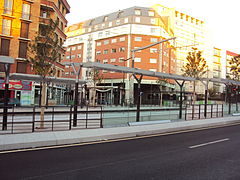
The Boulevard Périphérique, often called the Périph, is a limited-access dual-carriageway ring road in Paris, France. With a few exceptions, it is situated along Paris's administrative limit.

Belleville is a station on Paris Métro Line 2 and Line 11. The station is in the district of Belleville at the corner of the 10th, 11th, 19th and 20th arrondissements.
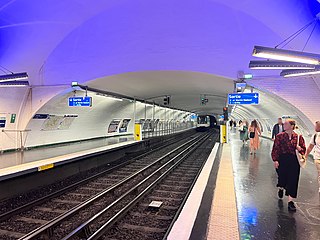
Gambetta is a station of the Paris Métro. It serves Line 3 and is the southern terminus of Line 3bis. It is located in the 20th arrondissement of Paris.

Porte de Bagnolet is a station on Paris Métro Line 3, located in the 20th arrondissement of Paris.
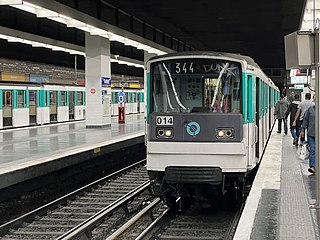
Gallieni is a station on Paris Métro Line 3, being its eastern terminus.

Porte des Lilas station is a station of the Paris Métro. It serves Line 11 and is the northern terminus of Line 3bis. Located on the edge of the 19th and 20th arrondissements of Paris, it serves the neighborhood of the Porte des Lilas. The station is named after the nearby Porte des Lilas, a gate in the nineteenth century Thiers Wall of Paris, which led to the town of Les Lilas.

Porte d'Italie is a station on Line 7 of the Paris Métro, and a stop on tramway T3a in the 13th arrondissement. It is named after the Porte d'Italie, a gate in the 19th century Thiers wall of Paris, which led to the south and Italy.
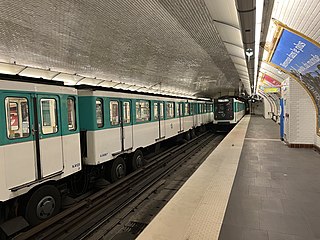
Mairie des Lilas is a station of the Paris Métro in the commune of Les Lilas and was formerly the eastern terminus of Line 11. It is named after the town hall of Les Lilas. A small underground depot is located near the station to service the trains of Line 11. The station is sometimes believed to be the subject of the Serge Gainsbourg song "Le Poinçonneur des Lilas", about a Métro ticket inspector, although the promotional film for it was filmed at the Porte des Lilas.

The Directorate-General for External Security is France's foreign intelligence agency, equivalent to the British MI6 and the American CIA, established on 2 April 1982. The DGSE safeguards French national security through intelligence gathering and conducting paramilitary and counterintelligence operations abroad, as well as economic espionage. It is headquartered in the 20th arrondissement of Paris.
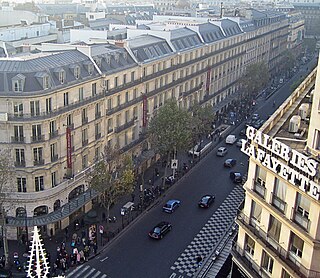
The Boulevards of Paris are boulevards which form an important part of the urban landscape of Paris. The boulevards were constructed in several phases by central government initiative as infrastructure improvements, but are very much associated with strolling and leisurely enjoyment in the minds of Parisians.

The Boulevards of the Marshals are a collection of thoroughfares that encircle the city of Paris, France, just inside its city limits. Most bear the name of a marshal of the First French Empire (1804–1814) who served under Napoleon I. The Île-de-France tramway Lines 3a and 3b today run on the Boulevards of the Marshals.
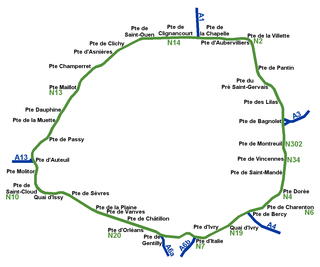
While Paris is encircled by the Boulevard Périphérique, the city gates of Paris are the access points to the city for pedestrians and other road users. As Paris has had successive ring roads through the centuries, city gates are found inside the modern-day Paris.

Porte de Clichy station is a station on Line 13 and Line 14 of the Paris Métro and RER C, as well as a stop on Île-de-France tramway Line 3b. Located in the 17th arrondissement, the Métro station is situated on the northwestern branch of Line 13, under the Avenue de Clichy. It serves the Tribunal de grande instance de Paris. The station is named after the Porte de Clichy, a gate in the nineteenth century Thiers wall of Paris, which led to Clichy.

The city walls of Paris refers to the city walls that surrounded Paris, as it grew from ancient times until the 20th century, built primarily to defend the city but also for administrative reasons. Several successive city walls were built over the centuries, either adding to existing walls or replacing demolished ones, through 1846, when construction of the Thiers wall was completed.

The Porte de Vincennes is one of the city gates of Paris (France) situated in the Bel Air neighborhood of the 12th arrondissement.

The Boulevard de l'Amiral-Bruix is a boulevard in the 16th arrondissement of Paris, France. It is one of the Boulevards of the Marshals that circle the outer parts of the city.
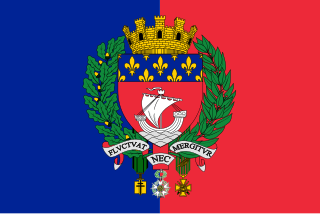
The following outline is provided as an overview of and topical guide to Paris:

The Boulevard Poniatowski is a boulevard in the Bel-Air, Picpus and Bercy neighborhoods in the 12th arrondissement of Paris, France. It is one of the Boulevards of the Marshals that run in the outer parts of the city.
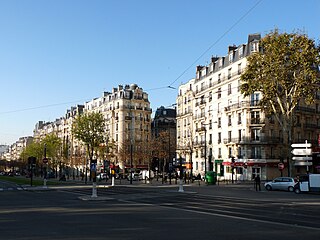
The Boulevard Lefebvre is a boulevard in the Saint-Lambert quarter in the 15th arrondissement of Paris, France. It is one of the Boulevards of the Marshals, which run in the outer parts of the city.

The Boulevard Soult is a boulevard in the Bel-Air neighborhood in the 12th arrondissement of Paris, France. It is one of the Boulevards of the Marshals that run in the outer parts of the city.




